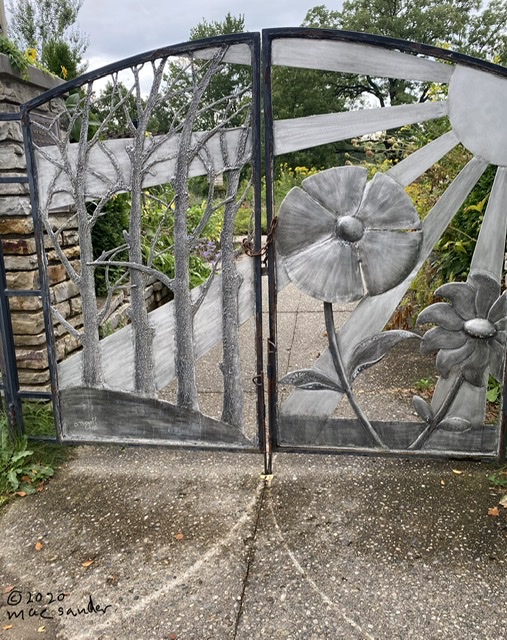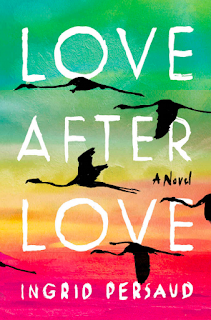My pantry is one of the best parts of my kitchen. This month, we have installed a new shelf that’s making a big difference in organizing. The new shelf mainly holds canisters of flour and other baking supplies for Len’s bread baking and other baking. Before it was installed, we piled the the lower shelf with canisters one on top of another to fit them in. Some were also in other parts of the pantry. This is much better and freed up more space for other foods. Len had to use some imagination and hard work to fit the shelf into the existing arrangement.
 |
| Above the new shelf are my three shelves of spice bottles and cans, and further above that are my Mona Lisa mugs. It's been a while since a new Mona Lisa mug arrived in my collection! |
 |
| Another view of the new shelf. |
In another part of the pantry, opposite the new shelf, I store a number of metal boxes from Christmas cookies in which I keep nuts, crackers, cookies, dried fruit, etc. In a bin below the shelves I store bags with onions and potatoes. You can also see my semi-organized canned goods, oils and vinegars, and other foods. Some of my reserve canned goods and paper goods are on shelves in the basement. Perhaps I should have more neatly rearranged the pantry for these photos, but I'm showing it to you in its native state.
 |
| Asian condiments |
One section is reserved for Asian condiments: Thai fish sauce, Maggi seasoning, sesame oil, soy sauce, black vinegar, ponzu sauce, and more. I like to try new ones, but I haven't had the opportunity to shop at specialty markets since the pandemic, so I am using what I already have.
 |
| One more view of my pantry. |
 |
| Canisters of flour in use for bread-baking. Yes, all the canisters have labels! |
In My Kitchen in August, 2020
At the end of each month, I like to write up what's going on in my kitchen and share it with other bloggers who also post kitchen news at the blog Sherry's Pickings (link). I've been posting about vegetarian experiments, summer produce, and other cooking projects throughout the month (especially in this post last Friday: Food, Wine, Distance), so this month, I'm just telling about my pantry and the one big new change in my kitchen -- the shelf!
In my contribution to Sherry's "In My Kitchen," I also like to reflect a little bit on current events. First and foremost, the terrible ongoing pandemic affects everything, including kitchen life. The food industry and society have in some ways have acted responsibly to help people in need. But in some cases the lives and health of workers and others have been jeopardized. As I've discussed before, I stopped buying meat from the industrial packing houses where so many workers have been infected by Covid, and I've adopted a more plant-centered diet. My sympathy for food workers also extends to the many restaurant workers and owners whose livelihoods have been disrupted or destroyed by the diminished business or permanent closing of restaurants, a situation that seems to be worsening.
Like many others, I suffer from the isolation and sadness of being locked down, but also feel guilty because I am unproductive. Above all, I am so little able to help those who are less fortunate than I am. I'm thinking of people losing access to adequate food, shelter, and basic human needs, whether from the economic downturn or from the natural and unnatural disasters that have hit several areas of the country. I hope for better times ahead.
In my contribution to Sherry's "In My Kitchen," I also like to reflect a little bit on current events. First and foremost, the terrible ongoing pandemic affects everything, including kitchen life. The food industry and society have in some ways have acted responsibly to help people in need. But in some cases the lives and health of workers and others have been jeopardized. As I've discussed before, I stopped buying meat from the industrial packing houses where so many workers have been infected by Covid, and I've adopted a more plant-centered diet. My sympathy for food workers also extends to the many restaurant workers and owners whose livelihoods have been disrupted or destroyed by the diminished business or permanent closing of restaurants, a situation that seems to be worsening.
Like many others, I suffer from the isolation and sadness of being locked down, but also feel guilty because I am unproductive. Above all, I am so little able to help those who are less fortunate than I am. I'm thinking of people losing access to adequate food, shelter, and basic human needs, whether from the economic downturn or from the natural and unnatural disasters that have hit several areas of the country. I hope for better times ahead.
Blog post and photos © 2020 mae sander for mae food dot blog spot dot com.















































